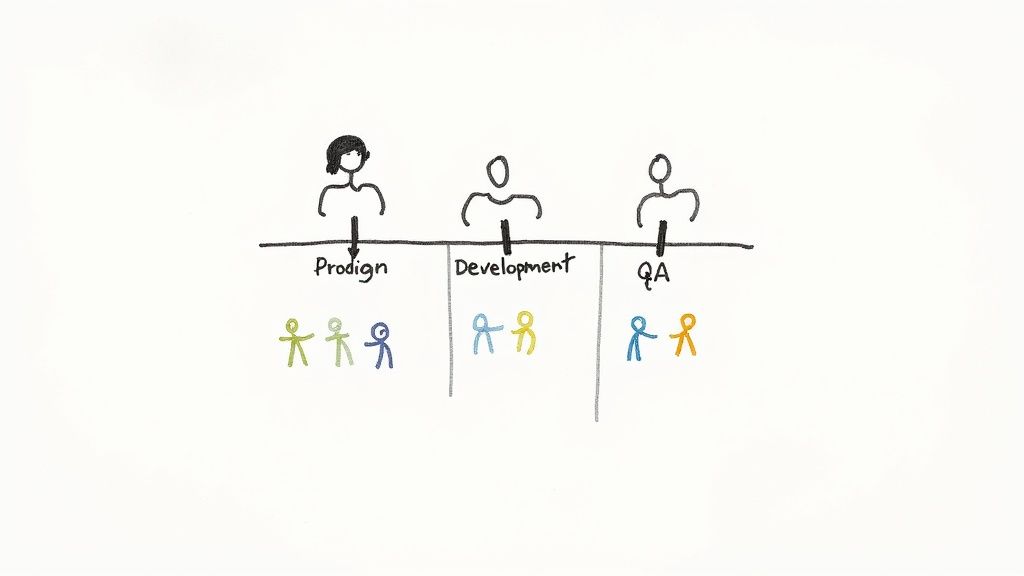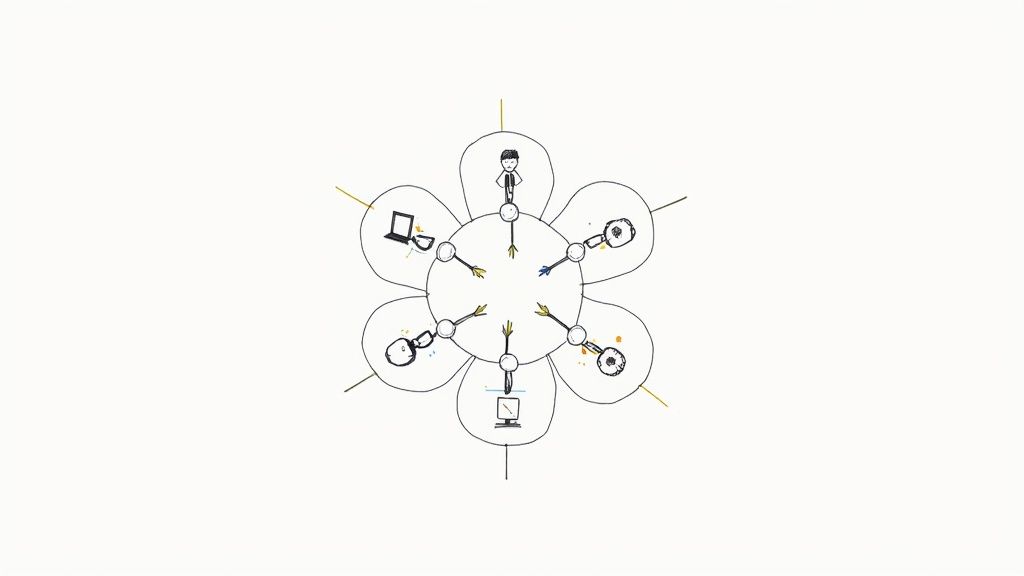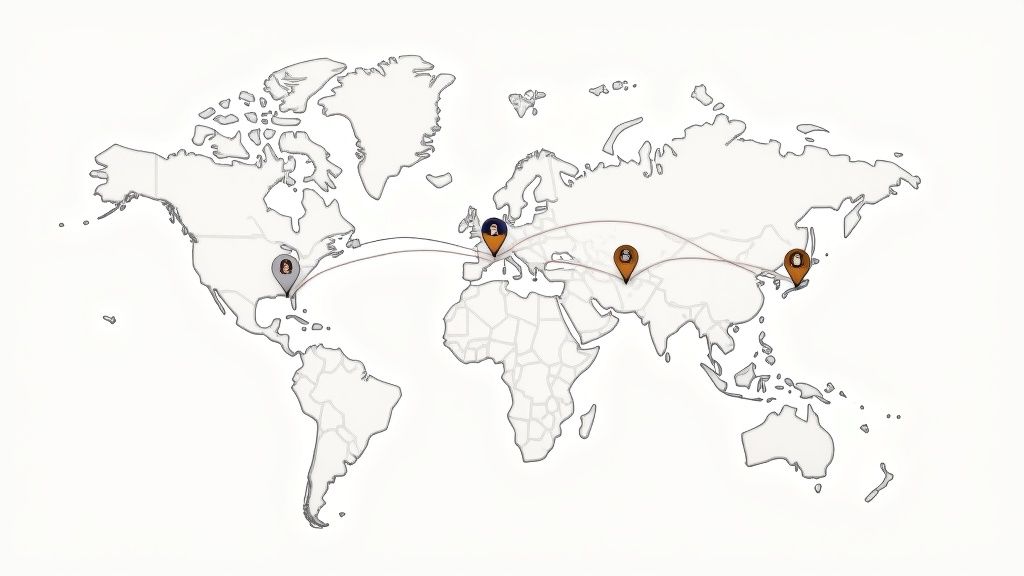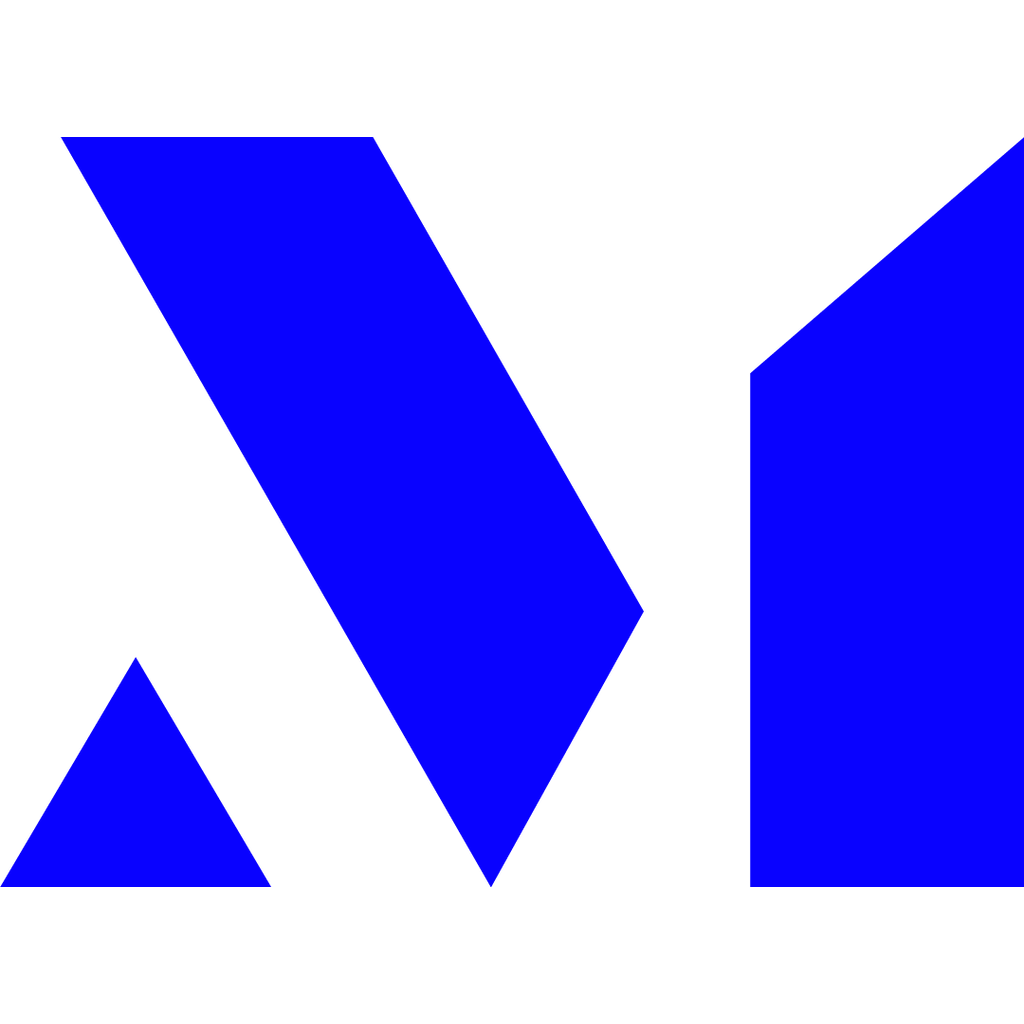Summary:
A product team structure is crucial for effective collaboration among product, engineering, design, and marketing teams, impacting communication, decision-making, and morale. Modern organizations increasingly adopt cross-functional and matrix models over traditional functional teams to enhance speed, autonomy, and innovation. Choosing the right structure depends on a company's size, goals, and culture, with newer models like Pods and Squads offering agility and ownership. As companies grow, structures like Tribes, Chapters, and Guilds help maintain alignment and expertise. Regularly reviewing and adapting team structures ensures they continue to support strategic objectives and organizational health.
Table of Contents
A product team structure isn't just an HR formality or a set of lines on an org chart. It's the operational blueprint for how your product, engineering, design, and marketing folks actually work together to build, launch, and grow your products.
Getting this right is one of the most critical decisions you'll make for your company's growth.
Why Your Product Team Structure Matters
Think of your team's structure as the foundation and framing of a house. A solid, well-designed blueprint makes for a sturdy, functional, and livable home. A flawed one creates endless problems-creaky floors, leaky pipes, and wasted space. You can have the best materials and the most skilled builders, but if the underlying structure is wrong, you're in for a world of trouble.
The same goes for your product teams. How you organize them has a direct, daily impact on everything from communication and decision-making to morale and accountability. It's the difference between a team that hums with purpose and one that’s stuck in a cycle of bottlenecks and confusion.
The Real-World Impact of Organizational Design
When you get the structure right, you're not just rearranging boxes on a chart; you're creating an environment for success. You're making sure everyone is rowing in the same direction, with a clear line of sight to the same goals.
Here’s what that looks like in practice:
- Faster Delivery: Teams with clear ownership and fewer dependencies simply move faster. They can take an idea from concept to customer without getting bogged down in endless approvals and handoffs.
- Higher Team Morale: Autonomy is a powerful motivator. When teams feel a genuine sense of ownership over their work, their engagement and job satisfaction skyrocket.
- Stronger Innovation: The best ideas often emerge from collaboration and experimentation. A good structure creates the psychological safety and operational freedom for those creative sparks to catch fire.
Ready to drive more growth & achieve bigger impact?
Leverage my 25+ years of successes and failures to unlock your growth and achieve results you never thought possible.
Get StartedThis is a big reason why we see so many companies shifting away from old-school models.

While traditional Functional Teams are still common, the data shows a clear trend. A combined 60% of organizations now use more modern, collaborative frameworks like Cross-Functional and Matrix teams. The shift is undeniable.
Quick Guide to Common Product Team Structures
To get your bearings, it helps to understand the main models people are using. Each one offers a different trade-off between specialization, speed, and resource sharing. Picking the right one depends entirely on your company’s size, goals, and culture.
Here’s a high-level summary of the most popular structures and where they tend to work best. Think of this as a quick-start map to help you figure out which path makes the most sense for your team's unique situation.
| Structure Model | Core Principle | Best For |
|---|---|---|
| Functional Teams | Grouping by expertise (e.g., all engineers together). | Early-stage companies building deep technical expertise and standardized processes. |
| Cross-Functional Teams | Creating small, autonomous teams with all needed skills. | Agile environments prioritizing speed, customer-centricity, and ownership of specific product areas. |
| Matrix Teams | Reporting to both a functional lead and a product lead. | Large organizations managing multiple complex projects that require shared resources and expertise. |
There’s no single "best" structure-only the one that’s best for you, right now. Understanding these core models is the first step toward building a team that's set up to win.
Exploring Traditional Functional and Matrix Models

Before agile squads and autonomous pods became the talk of the town, most companies relied on more conventional product team structures. Two of the most enduring are the Functional and Matrix models. While newer methods often grab the spotlight, you can’t ignore these foundational approaches. Plenty of companies still use them, especially in more established or regulated industries where stability trumps speed.
These models were built around managing expertise and resources, not the fast-paced autonomy we see in many tech teams today. They represent a more centralized way of organizing talent, with clear hierarchies and reporting lines. Let's break down each one to see how they work, where they shine, and where they tend to fall short.
The Functional Team Structure
The Functional model is probably the most straightforward way to organize people. Think of it like a traditional company org chart with clear-cut departments: Engineering, Design, Marketing, and so on. Each group is run by a functional head-a VP of Engineering, a Director of Design, you get the picture.
Ready to drive more growth & achieve bigger impact?
Leverage my 25+ years of successes and failures to unlock your growth and achieve results you never thought possible.
Get StartedIn this setup, team members are grouped by their specific skills. Engineers work with other engineers, designers huddle with fellow designers, and everyone reports up a single chain of command based on their discipline. The whole model is built to cultivate deep expertise in a given field.
Key Insight: The biggest win for a Functional structure is its focus on developing excellence within a discipline. It creates a clear career path and strong mentorship, as junior folks learn directly from senior experts in their field.
But that intense focus on specialization comes with a serious trade-off. When it's time to actually build a product, the work gets handed off from one department to the next like a baton in a relay race. This creates silos, slows down decisions, and can lead to a painful game of "telephone" where the product's vision gets fuzzy with each handoff.
The Matrix Team Structure
The Matrix model was born from an attempt to fix the silo problem of the Functional structure while keeping its benefits. It’s a hybrid approach where an employee essentially has two bosses. They report to their functional manager (like the Head of Engineering) and to a product or project manager.
It’s like being a specialist consultant assigned to a specific mission. You have your home base (the engineering department) where you sharpen your skills, but your day-to-day work is guided by the project lead you're supporting. This lets a company spread its experts across multiple products without constantly reshuffling the org chart.
Advantages of the Matrix Model:
- Efficient Resource Sharing: A single, top-tier designer or a specialized backend engineer can lend their expertise to several product initiatives at once.
- Skill Development: Team members don't lose the mentorship and standards set by their functional department.
- Flexibility: It allows organizations to spin up and wind down project teams as business priorities change, all without a massive reorganization.
This sounds great on paper, but in practice, it often leads to the classic "two bosses" dilemma. When the product manager’s tight deadline clashes with the functional manager’s directive on technical quality, who does the engineer listen to? This dual-reporting system can create conflicting priorities, confusion, and a major slowdown as team members get caught in the middle.
Making a Matrix model work requires incredibly strong leadership and crystal-clear communication to prevent total gridlock. For a deeper look into how these dynamics play out, you can find more detail in this helpful guide to software development team structures.
While newer models have taken over in many tech circles, both the Functional and Matrix structures are still very much alive. They show up in large, complex enterprises where optimizing resources and maintaining deep specialization are the name of the game. Their rigid nature provides stability, but it often comes at the cost of the agility needed to innovate quickly.
Adopting Modern Pods and Squads

As companies feel the squeeze to innovate faster and faster, old-school functional and matrix structures just can’t keep up. They’re too slow, too siloed, too cumbersome. This pressure has given rise to more agile product team structures that are built for speed, autonomy, and a deep connection to the customer.
The two models you’ll hear about most are Pods and Squads.
Think of a Squad or a Pod less like a department and more like a small, self-sufficient "mini-startup" that lives inside the larger company. Each team is a cross-functional unit with all the skills needed to take an idea from concept to launch: product, engineering, design, and often analytics or QA. The entire point is to break down the walls between departments and give a single team complete ownership over a customer problem or business goal.
The Power of True Ownership
The philosophy here is simple but profound: stop shipping features and start delivering results. So many organizations get stuck in the "feature factory" trap. In fact, one report found that a staggering 54% of product roadmaps are focused on output-what gets built-instead of outcomes, which is the actual impact on customers and the business.
This is exactly the problem that autonomous teams like Pods and Squads are designed to fix. Instead of being handed a list of features to build, a Squad gets a mission-something like, "improve user retention by 15%." From there, they have the freedom to figure out the best way to hit that target.
The Big Shift: Modern product team structures like Pods and Squads redefine success. It's no longer about how many features you ship per quarter; it's about how much value you create for your customers and the business.
This shift in thinking does wonders for team morale and performance. When a team has real ownership over a problem, their sense of responsibility and engagement skyrockets. They stop being order-takers and start acting like problem-solvers. Of course, to make this work, teams need a strong operational foundation, which is why many lean on established Agile Software Development Best Practices.
Scaling Autonomy With Tribes, Chapters, and Guilds
A fair question comes up pretty quickly: if you have dozens of autonomous Squads all running in different directions, how do you keep everyone from descending into chaos?
This is where the scaling framework popularized by Spotify comes into play, introducing a few more key concepts: Tribes, Chapters, and Guilds.
- Tribes: Think of a Tribe as a collection of Squads all working in a related area. For example, you might have a "User Onboarding Tribe" or a "Mobile Experience Tribe." This adds a layer of alignment, ensuring all the individual Squads are rowing in the same general direction toward a larger mission.
- Chapters: A Chapter groups people by their functional expertise across different Squads. All the frontend engineers, for instance, belong to the Frontend Chapter, regardless of which Squad they’re on. This is how you maintain high standards and share best practices. The Chapter Lead is usually a senior expert who mentors others in their craft.
- Guilds: Guilds are the most informal layer. They are voluntary, company-wide communities of interest. Anyone can join a Guild to share knowledge and passion for a topic, like "accessibility," "A/B testing," or "machine learning."
This framework strikes a brilliant balance. Squads get the autonomy they need to move fast, while Tribes, Chapters, and Guilds provide the connective tissue that keeps the whole organization aligned, skilled, and constantly learning. It’s a structure built for both speed and scale.
How Company Size Shapes Your Team Design
There’s no magic bullet for product team structure. The "best" design isn't a fixed target; it's a moving one, shaped entirely by your company's size, maturity, and complexity. A two-person garage startup and a global enterprise are different beasts, and your organizational blueprint has to match your reality today-not where you hope to be tomorrow.
For a tiny startup chasing its first big win, formal structure is just friction. Collaboration is fluid, roles overlap, and everyone is plugged directly into the mission. A rigid org chart would only slow down the rapid-fire iteration needed to survive and find product-market fit.
Startups and Small Companies
In the early days, a simple, flat structure is usually the way to go. The entire company often acts as one big, cross-functional team. Think of it less as a formal structure and more as a single, highly motivated squad laser-focused on one thing: growth.
The real advantage here is pure speed and agility. You can make decisions in minutes, not meetings, and the loop between building, shipping, and learning is incredibly tight. The main challenge isn't wrestling with organizational charts; it's fighting resource constraints.
Key Takeaway: In the beginning, your structure is the shared mission. You only need to start thinking about formal product teams when informal communication starts to break down, which usually happens once you grow beyond a dozen or so people.
While company size is a huge driver, it's not the only factor. For those interested, you can explore alternative perspectives on team size and structure that argue workflow and efficiency can be even more important.
Mid-Sized and Scaling Companies
As you grow, that single-team model starts to creak and groan under the weight. The product gets more complex, feature requests pile up, and the cognitive load on any single person becomes overwhelming. This is the inflection point where you have to get intentional about your design.
This is when you'll see dedicated pods or squads emerge, each owning a specific slice of the user journey or product. A SaaS company, for instance, might split into teams like:
- Onboarding & Activation: Focused on getting new users to that "aha!" moment as fast as possible.
- Core Experience: Dedicated to making the main, value-driving features better.
- Growth & Monetization: Tasked with running experiments to bring in more users and drive revenue.
Ready to drive more growth & achieve bigger impact?
Leverage my 25+ years of successes and failures to unlock your growth and achieve results you never thought possible.
Get StartedMaking this shift from one big team to several smaller, focused units is a major step. It forces you to define ownership clearly and build new ways to keep everyone aligned. Otherwise, you risk the product feeling disjointed. A well-defined product org structure is no longer a "nice-to-have"-it's vital for managing the chaos and making sure every team is pulling in the same direction.
Large Enterprises
Once you hit enterprise scale-with hundreds or thousands of employees and multiple product lines-the challenges multiply again. Now, it's not just about team-level autonomy; it's about managing a whole portfolio of products and business units without grinding to a halt.
In large organizations with 50+ people in product teams, the structure is absolutely critical for managing complexity while still fostering innovation. A company like Microsoft is a classic example. They use a product line structure, with dedicated organizations focused on massive products like Office, Windows, and Azure. This allows teams to build deep expertise and accountability within their specific domains.
At this scale, you often see a hybrid, layered approach. It might look something like this:
- Divisions: Organized around major business units (e.g., "Consumer Products" vs. "Enterprise Solutions").
- Tribes: Aligned to strategic initiatives or customer segments within that division.
- Squads: The core execution units, operating with autonomy to achieve their Tribe's mission.
The goal is to create a system that balances high-level strategic alignment with deep, focused execution. It’s a constant search for the sweet spot between centralized governance and decentralized ownership, so that even in a massive company, small teams feel empowered to make a real impact.
Implementing a New Product Team Structure
Shifting your product team structure isn’t just about redrawing an org chart. It's a massive operational and cultural change. Moving from the theoretical upsides of a new model to a real-world rollout takes serious planning and a people-first mindset. Success lives or dies by a clear, phased process that keeps disruption low and builds momentum.
Think of it like renovating a house while you're still living in it. You wouldn't just knock down all the walls at once. Instead, you'd tackle it one room at a time, sealing it off to contain the mess so the rest of the house stays livable. A structural change in your product org requires the same deliberate, methodical approach to avoid total chaos.
Audit Your Current Pains
Before you can build something better, you have to get painfully honest about what’s broken right now. The first step is a thorough audit of your current reality. Don’t just look at dashboards; go talk to the people doing the work.
Are teams constantly blocked by dependencies? Is morale in the tank because no one feels a sense of ownership? Are your best engineers stuck in endless meetings instead of building? Get specific. Quantify the pain. Document how many teams it takes to ship a simple feature or how long the average decision-making process drags on.
Define Your Strategic Goals
With a clear picture of your problems, the next step is to define what winning looks like. Your new structure has to be a direct response to your strategic goals. Vague hopes like "be more agile" just won't cut it.
You need concrete, measurable objectives. Are you trying to:
- Reduce time-to-market for new features by 25%?
- Increase team autonomy and slash cross-team dependencies by 50%?
- Improve product quality by giving teams clear ownership over specific parts of the user journey?
These goals become your North Star. They guide which model you choose and, just as importantly, help you measure whether the change actually worked.
Plan a Phased and Communicated Rollout
Once you've picked a model that lines up with your goals, it's time to plan the switch. A "big bang" changeover is incredibly risky and almost always ends in confusion, resistance, and failure. A phased rollout is nearly always the better way to go.
Start with a pilot team. Pick a single squad or pod to pioneer the new structure. This lets you test the new roles, communication patterns, and workflows in a controlled environment. You can gather feedback, iron out the kinks, and-ideally-create a success story that builds buy-in from everyone else.
This transition is fundamentally an exercise in change management. Clear, consistent, and empathetic communication is non-negotiable. Leadership must articulate the "why" behind the change, addressing concerns head-on and painting a compelling vision of the future.
Managing this human element is everything. For a deeper dive into guiding teams through these kinds of transitions, explore effective strategies for leadership in change management. As you implement the new structure, tapping into your existing talent through smart talent redeployment strategies can be a game-changer for building the right teams and ensuring a smooth transition.
The final, and perhaps most important, step? Treat your new structure like an iterative product itself. Set up feedback loops, check in with teams regularly, and be ready to adapt the design as your company and your challenges continue to evolve.
Taking Your Product Global? Your Org Chart Needs a Passport, Too.

So, you’ve conquered your home market. Fantastic. But when your ambition crosses borders, your product team structure has to come with you. A model that runs like a dream in a single country will sputter and stall when it hits the wall of different cultures, tangled local laws, and completely foreign customer habits.
You can't just export your domestic playbook and expect it to work. That's a classic recipe for failure. What you need is a structure that can hold a global vision steady while giving local teams the freedom to actually win on the ground.
This isn’t about just translating your app into a few more languages. It's about fundamentally rethinking how products get built and shipped for different corners of the world. A product manager’s entire world-their priorities, their challenges, their definition of success-can change dramatically from one market to the next.
The Global-Local Tightrope Walk
The real trick is balancing a unified, global strategy with the autonomy needed for local execution. It’s a tightrope walk. You need a central vision to keep your product from splintering into a dozen disconnected, Frankenstein-like versions. But you also need people on the ground-local experts-who can make smart, fast decisions without getting stuck in a "wait for HQ to approve" feedback loop.
How do you do that without the whole thing collapsing? Two structures tend to rise to the top:
- Regional Product Hubs: This is about creating centers of gravity in key markets. Think of a hub in London for EMEA or one in Singapore for APAC. You staff these hubs with dedicated product, design, and engineering talent who live and breathe the unique needs of their region. They become the bridge between the global Mothership and the local markets.
- Divisional Teams: For bigger companies, this is a common and powerful approach. You organize entire product teams into divisions based on geography. A European divisional team, for instance, becomes the in-house expert on everything from GDPR to regional sustainability demands. Meanwhile, your Asian division is mastering mobile-first design and the art of hyper-localization for dozens of distinct cultures.
The goal is to push decision-making power out from the center. When you empower local leaders, you're not just getting your product used-you're getting it to resonate. You're building something that feels native, not foreign. That's how you build a truly global brand.
You can see these regional differences play out in the talent market, too. The demand for product managers varies wildly around the world, shaped by totally different economic forces. In Europe, you see a lot of roles in finance and manufacturing, with a huge emphasis on regulatory compliance and sustainability.
Flip over to the Asia-Pacific region, and it’s a different story. Rapid digitalization is fueling a massive demand for product managers who are masters of navigating culturally diverse markets. You can find more details on these trends in this analysis of global product management demand on ProductLeadership.com.
Common Questions About Product Team Structures
As you start exploring different product team structures, a few questions always seem to pop up. Getting clear on these early can save you a lot of friction down the road. Let's tackle some of the most common ones I hear from product leaders.
Which Product Team Structure Is Most Popular Today?
If you're looking at the tech world, especially companies focused on rapid innovation, the Squad model has become incredibly common. It’s a type of cross-functional team that’s prized for its speed and autonomy, letting a small group own a problem from start to finish.
But popularity isn't the whole story. Many larger, more established companies still run on traditional Matrix or Functional structures, and for good reason. These models are often more efficient with resources and allow for deep specialization, which can be a huge advantage in certain industries.
The truth is, there’s no single "winner." The best choice isn't about following a trend. It’s about finding the model that genuinely fits your company’s culture, your industry's demands, and your most important strategic goals.
How Often Should We Rethink Our Team Structure?
Your org chart isn't a "set it and forget it" document. It’s a living thing. The moment you stop evaluating it is the moment it starts holding you back. A good rule of thumb is to formally review your structure at least once a year.
But some events should trigger a review immediately. Think of them as inflection points-clear signals that the way you're working might not be the best way to keep working.
- A significant new round of funding that radically changes your growth targets.
- A major new product launch that takes the company into new territory.
- Persistent bottlenecks or communication breakdowns that just won’t go away.
- A strategic pivot into a completely new market or customer segment.
Key Insight: Don't wait for the whole thing to break. Proactive, regular reviews let you make small, smart adjustments instead of being forced into a massive, disruptive re-org later on.
Who Is Responsible for Deciding the Team Structure?
Ultimately, this responsibility lands on the desk of the highest-ranking product leader. In most organizations, that’s the Chief Product Officer (CPO) or the VP/Head of Product.
This person is accountable for designing an organization that can actually execute the product vision. It's their job to work hand-in-glove with other leaders, especially the heads of Engineering and Design, to make sure the structure supports not just product goals but technical health and great user experience, too.
While the CPO or VP leads the charge, it shouldn’t happen in a vacuum. The best leaders make it a collaborative process. They actively seek input from team leads and even individual contributors-the people on the ground who feel the friction of a broken structure every single day.
Are you a product leader tasked with designing or evolving your organization? Matthew Mamet offers specialized growth and leadership coaching to help executives like you build high-performing teams and drive sustainable results. Learn how to refine your product strategy and team structure for maximum impact by visiting https://matthewmamet.com.
Ready to drive more growth & achieve bigger impact?
Leverage my 25+ years of successes and failures to unlock your growth and achieve results you never thought possible.
Get Started



